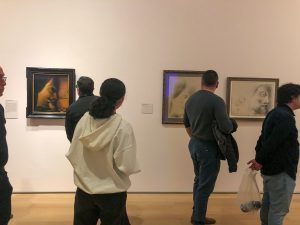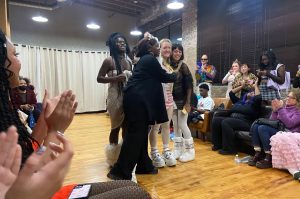
The Center for Intuitive and Outsider Art has been around for nearly 25 years and is the only nonprofit organization in the United States solely dedicated to outsider art.
As the museum gets ready to celebrate its anniversary in a unique way next year, the staff credits its success to the showcasing of artists who aren’t formally taught as well as Intuit’s ability to attract audiences that aren’t typically prone to attend art museums.
In 1983, the Corcoran Gallery of Art put on a black folk art exhibit at the Field Museum. It was the first time that many people in America got the opportunity to witness this genre of art. Many people fell in love with it, including the enthusiasts that got together to create Intuit in 1991, after deciding this genre of art needed to be promoted more.
Intuit started off without a facility, doing pop-up exhibits before the term was actually coined. Intuit later started making their exhibits more regular in what is now known as the Roger Brown Study Collection. Finally, in 1999 Intuit moved to its current location, formally the Randolph Street Gallery.
Although there is no set definition of outsider art, Executive Director at Intuit, Debra Kerr, says that outsider art, also called art brut, is self-taught art or art that is outside the mainstream of the art academy.
Kerr says it is art that can drive something out of someone onto a creative platform, which is why anyone can do it, including people who are disabled or grew up in harsh living conditions.
“The outsider art isn’t just about the art, it’s about the story of the artist,” Kerr said.
In spring 2000, Intuit obtained contents from outsider artist Henry Darger’s living and working space.
Eight years later, Intuit made The Henry Darger Room Collection a permanent exhibit giving readers a glimpse into Darger’s personal life and struggles.
“Henry was someone  who was a recluse for 40 years and who was probably abused as a child,” Kerr said.
who was a recluse for 40 years and who was probably abused as a child,” Kerr said.
“When he was actually committed to a place, believe it or not, it was to a place that was actually called the ‘Asylum for Feeble Minded Children’ and that art obviously is a product of Henry’s own creativity, but it was also a product of the times he lived in and the circumstances that he lived in,” Kerr said.
For many of the artists that feel powerless and out of control of their lives, outsider art has become their platform to take their power back. This is exemplified by Inez Nathaniel Walker’s painting, which hangs on the wall in Kerr’s office. The colorful piece is a product of someone who’s been through a lot.
“She was in prison for manslaughter for killing a man that was likely abusing her, but she got out pretty quickly,” Kerr said.
After getting out of prison Nathaniel Walker devoted the rest of her life to drawing.
On the other side of her office, Kerr has another piece of art done by a survivor of the 1915 Armenian Genocide, who at the age of seven had lost her parents and gotten separated from her brother when evacuating a train. She later walked to Greece by herself.
“When we look at this face, we begin to think maybe it’s not as straightforward, but I think it’s very accessible,” Kerr said of the colorful face on the painting.
That’s exactly what Kerr wants visitors to think when they visit Intuit: that the art is accessible to anyone and not off-putting to visitors.
This is why Intuit has done work with people with dementia, blind and low-sided people, homeless people and developmentally challenged people.
Intuit’s current exhibit, which runs through January and features the work of artists such as Henry Darger and Martin Ramirez, is the perfect example of outsider art’s ability to reach people of all walks of life and bring their creative impulse out.
The “Draw” exhibit includes comfy chairs, drawing pads and color pencils with the intention to get people to sit down and draw. The exhibit was also sparked by Kerr’s belief that multi-sensory programming plays a big part in attracting millennials, who don’t just want to look at walls in the museum.
That attitude along with a lot of the artwork being done by minorities has resulted in Intuit having a higher percentage of younger and minority visitors than most art museums tend to have.
“We don’t have a huge attendance, but I think it’s a pretty mixed group,” Kerr says. “I’d just like to have all the numbers increase like 10 more people coming in and seeing us and having a great experience with us.”
Kerr’s bubbly and sweet personality is a key factor in making everyone’s experience at Intuit a comfortable, enjoyable experience. If there’s a school visiting the museum, she makes sure to throw on her hat, go downstairs and greet them.
“I come downstairs and I say, ‘I don’t care what color you are. I don’t care what your orientation is. I don’t care if you’re feeling great about yourself or you’re not feeling great about yourself. This is a place where you’re welcome, I want you to come back.'”
“I know we have a suggested admission fee, but when you come in the door, you can say Ms. Deb sent you and if you can’t remember my name, say the lady with the hat sent you. I once gave that speech and then later on I had a boy say Ms. Hat, Ms. Hat! I want to show you something.”
Twenty percent of Intuit’s funding goes to the Intuit Teacher Fellowship Program, a yearlong program which was put together by education committee chair Jerry Stefl. Stefl still helps with the program, which brings in at least 20 kindergarten through 12th grade teachers from at least 10 Chicago Public and gives them training sessions in the fall that include workshops and field trips to outsider museums.
Teachers in the program are paired with another teacher, preferably of a different subject matter.
“It’s a very innovative program in the sense that it’s integrating arts curriculum into multiple disciples and it’s creating a learning community for teachers to work together and do things outside of classroom time,” said Joel Javier, Education Manager at Intuit.
“Rather than working in solitude and working on their own lesson plan, they get to collaborate and work together.”
The program has reached over 10,000 students during its course, including 730 students from the 2014-2015 school year. Ninety percent of the students in the program from the 2014-2015 school year came from low-income families and received free or reduced school lunches.
One of Javier’s favorite parts about the program is that it introduces the students to artists who they share something in common with, especially students dealing with disabilities.
“I feel like when you are able to expose art from other artists with disabilities, that the students who have developmental disabilities might be able to connect a little easier because they have something in common, so I think that’s important,” Javier said.
After five sessions, presenting their lesson plans and getting feedback, the teachers implement the tools into their spring lesson plans for their students with the support of Intuit’s staff. At the end of the program in June, selected student work is showcased for family members and friends to see.
The program has won two awards one in 2009 from the Illinois Art Education Association for Outstanding Contributions in Distinguished Service in the Profession of Art Education and another in 2011 from the Illinois Association of Museums for Superior Achievement.
From a competitive standpoint, true to the norm in the industry, Intuit looks at other museums as collaborators more than competitors.
“There are lots of cultural opportunities for people,” Kerr said.
“What I want to do is distinguish us in this community by positioning us as the most accessible museum and we’re not the physically most accessible, but we’re working on that, but I think that the art is easily understood by anyone.”
In 1992, Intuit started their print magazine: The Outsider Magazine, designed to teach people more about outsider art and to reach audiences outside of Chicago.
“This is a key to one tool that we use to build our reputation, not just as a hard-copy, but also as an online resource,” Kerr said.
Although Kerr has only been at Intuit for a year, she’s already seen an increase in attendance. The museum is now open on Sundays and Monday holidays when people are off work and school and families are looking for something to do.
“We’re trying to be robust about reaching the media, that’s been a problem since we’re such a small place, but we’ve got a number of new initiatives to bring people in,” Kerr said.
One of those new initiatives is Intuit’s 25th anniversary exhibit, which will be curated by Faheem Majeed and circle back into black folk art, one of the very reasons Intuit got its start. The exhibit will take a look back at some of the artwork that was featured in the 1983 exhibit as well as what is happening in black outsider art today.



















Be First to Comment